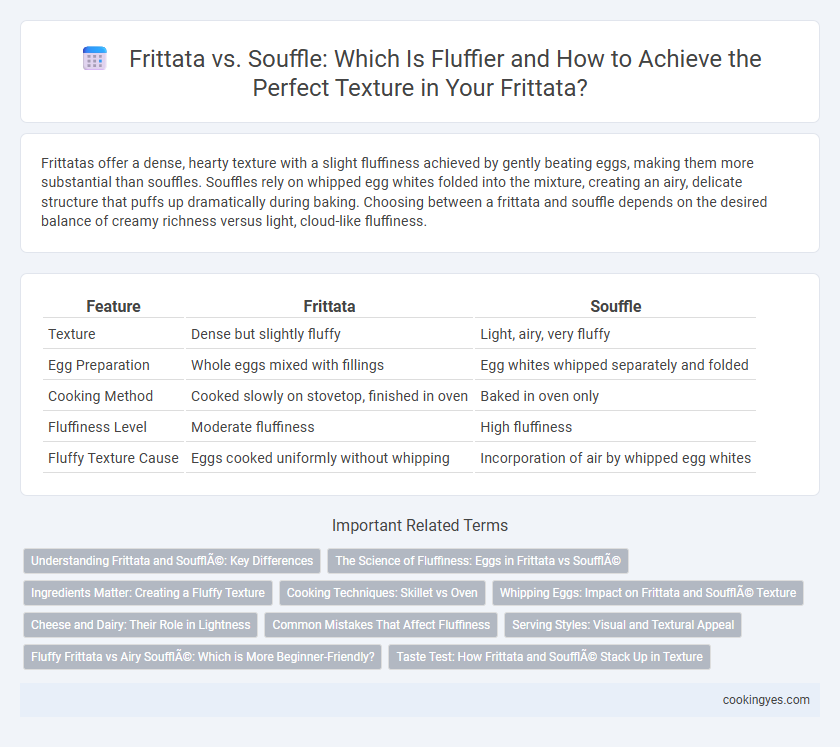Frittatas offer a dense, hearty texture with a slight fluffiness achieved by gently beating eggs, making them more substantial than souffles. Souffles rely on whipped egg whites folded into the mixture, creating an airy, delicate structure that puffs up dramatically during baking. Choosing between a frittata and souffle depends on the desired balance of creamy richness versus light, cloud-like fluffiness.
Table of Comparison
| Feature | Frittata | Souffle |
|---|---|---|
| Texture | Dense but slightly fluffy | Light, airy, very fluffy |
| Egg Preparation | Whole eggs mixed with fillings | Egg whites whipped separately and folded |
| Cooking Method | Cooked slowly on stovetop, finished in oven | Baked in oven only |
| Fluffiness Level | Moderate fluffiness | High fluffiness |
| Fluffy Texture Cause | Eggs cooked uniformly without whipping | Incorporation of air by whipped egg whites |
Understanding Frittata and Soufflé: Key Differences
Frittatas and souffles both deliver fluffy textures but achieve them through different techniques; frittatas rely on whole eggs mixed with various ingredients and cooked slowly to create a dense yet airy consistency, while souffles use beaten egg whites folded into a flavored base, resulting in a light, delicate rise. The key difference lies in their preparation: frittatas are pan-cooked and hearty, making them suitable for robust ingredients, whereas souffles require precise folding and baking in the oven, producing a more ethereal, puffed texture. Understanding these distinctions helps in choosing the right dish for desired fluffiness and presentation.
The Science of Fluffiness: Eggs in Frittata vs Soufflé
Eggs in a frittata create fluffiness through gentle folding and slow cooking, allowing proteins to coagulate gradually and trap air. In contrast, souffles rely on whipped egg whites to incorporate maximum air, which expands during baking for an airy, delicate structure. The difference in technique influences texture: frittatas are denser and creamier, while souffles achieve a higher rise and lighter, more ethereal fluffiness.
Ingredients Matter: Creating a Fluffy Texture
Eggs with well-beaten whites and careful folding create the airy structure essential for a souffle's signature fluffiness, while frittatas rely on whole eggs beaten uniformly for a denser yet tender texture. Incorporating dairy such as cream or milk in both dishes influences moisture content and softness, but souffles often benefit from a higher ratio of egg whites to yolks to maximize lift. The choice of leavening techniques and ingredient proportions directly impacts the final fluffiness, distinguishing souffles as light and airy compared to the richer, custard-like texture of frittatas.
Cooking Techniques: Skillet vs Oven
Frittatas achieve their fluffy texture through gentle stovetop cooking in a skillet, allowing eggs to set slowly and evenly without excessive rise. Souffles rely on oven baking, where whipped egg whites create an airy, puffed structure that expands with heat and deflates upon cooling. The skillet method emphasizes gradual heat application and moisture retention, while the oven technique leverages steam and air incorporation for volume.
Whipping Eggs: Impact on Frittata and Soufflé Texture
Whipping eggs incorporates air, creating distinct textures in frittatas and souffles. In souffles, vigorously whipped egg whites form stiff peaks, resulting in a light, airy, and delicate structure. Frittatas rely on whole eggs beaten until uniform without extensive whipping, producing a denser, creamy texture that remains tender yet sturdy.
Cheese and Dairy: Their Role in Lightness
Cheese varieties like ricotta and mozzarella contribute moisture and protein to a frittata, enhancing its tender, fluffy texture without excessive air incorporation. In souffles, dairy ingredients such as cream and cheese are combined with whipped egg whites to create a delicate structure that traps air, resulting in an airy and light rise. The higher fat content in souffle dairy elements aids in stabilizing foam, distinguishing its lightness from the denser, custard-like texture of a frittata.
Common Mistakes That Affect Fluffiness
Overbeating eggs in frittatas can cause a dense texture rather than the desired fluffiness found in souffles, which rely on carefully whipped egg whites. Using heavy fillings in frittatas often weighs down the mixture, preventing it from rising properly, whereas souffles benefit from light, airy components. Inadequate heat control during cooking leads to uneven rising in both dishes but is particularly detrimental to souffles, where precise oven temperature is crucial for achieving a fluffy texture.
Serving Styles: Visual and Textural Appeal
Frittatas offer a rustic, open-faced presentation with a slightly denser, yet tender texture that holds well when sliced, making them ideal for casual serving styles. Souffles present an elevated, airy visual with a delicate, cloud-like texture that deflates quickly, best served immediately in individual ramekins to preserve their signature fluffiness. The contrasting textures and presentation highlight frittatas' heartiness versus souffles' elegance, influencing the choice based on dining context and visual impact.
Fluffy Frittata vs Airy Soufflé: Which is More Beginner-Friendly?
A fluffy frittata offers a dense yet tender texture achieved by gently incorporating eggs and minimal whisking, making it ideal for beginners due to its forgiving cooking process and simple pan-frying technique. In contrast, an airy souffle relies on finely whipped egg whites folded into the base, requiring precise timing and skill to maintain its delicate rise and prevent collapse. While souffles provide an elegant, cloud-like texture, the frittata's robustness and straightforward preparation make it more accessible for novice cooks aiming for a fluffy egg dish.
Taste Test: How Frittata and Soufflé Stack Up in Texture
Frittatas deliver a dense yet tender texture with a rich, savory flavor, while souffles boast an airy, delicate fluffiness due to whipped egg whites. In texture-focused taste tests, souffles often impress with their lightness and melt-in-the-mouth quality, contrasting with the hearty, more substantial bite of a frittata. Both dishes offer unique mouthfeel experiences: frittatas balance moisture and firmness, whereas souffles achieve peak fluffiness and ethereal softness.
Frittata vs Soufflé for Fluffy Texture Infographic

 cookingyes.com
cookingyes.com